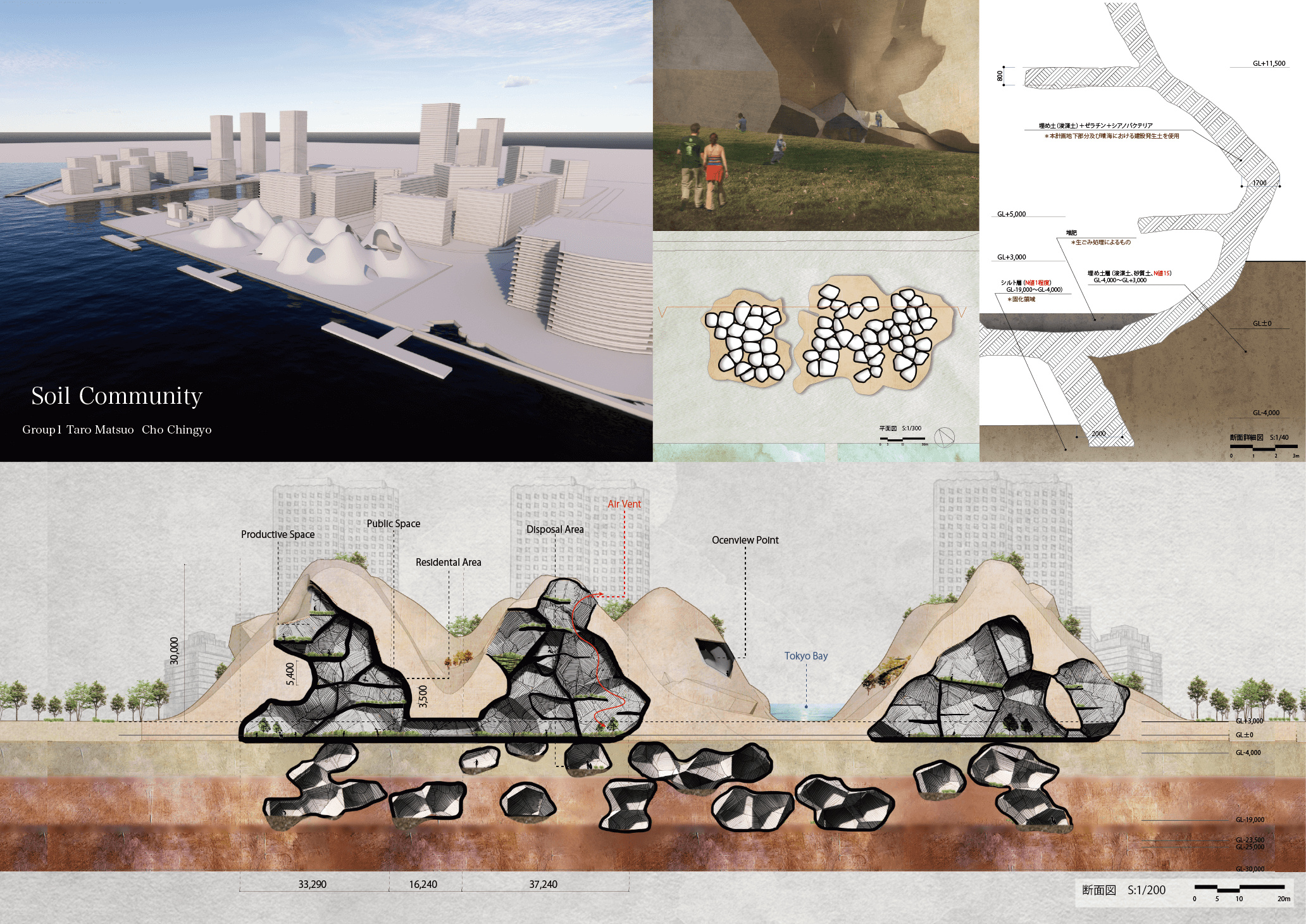
|
Everything on the earth is eventually absorbed by the soil, which changes its form and releases it. Soil is the most "medium" material on earth.
In the soil architecture proposed here, the space itself is constructed with the medium of soil,
and the activities of the individual are transformed by the soil into activities for the whole, becoming a device that forms a comprehensive and multilayered global community in its process and results.
The site is Harumi Pier Park, a reclaimed land. Here, people mainly grow crops and dispose of household garbage in the soil.
These activities are transformed into soil composting and ground strengthening activities by the microorganisms in the building, healing the ecosystem of the man-made landfill and preventing liquefaction.
With soil, people form communities with microbes, nature, and other inhabitants.
地球上のありとあらゆるものは最終的に土に吸収され、形を変えて放出する。 土は地球における最も「媒体性」を有する素材である。今回提案する土の建築は空間そのものが土による媒体で構築され、個人の活動は土によって全体への活動へと変換され、その過程及び結果において総括的で重層的な地球規模のコミュニティを形成する装置となる。 敷地は埋立地の晴海ふ頭公園である。人はここでは主に農作物を育て、家庭の生ごみを土に処理させる。 これらの活動は建築内の微生物の作用により、土壌の堆肥化、地盤強化という活動に変換され人工の埋立地の生態系を癒し、液状化を防ぐ。 人は土でもって微生物、自然、他の住居者とコミュニティを形成する。 |
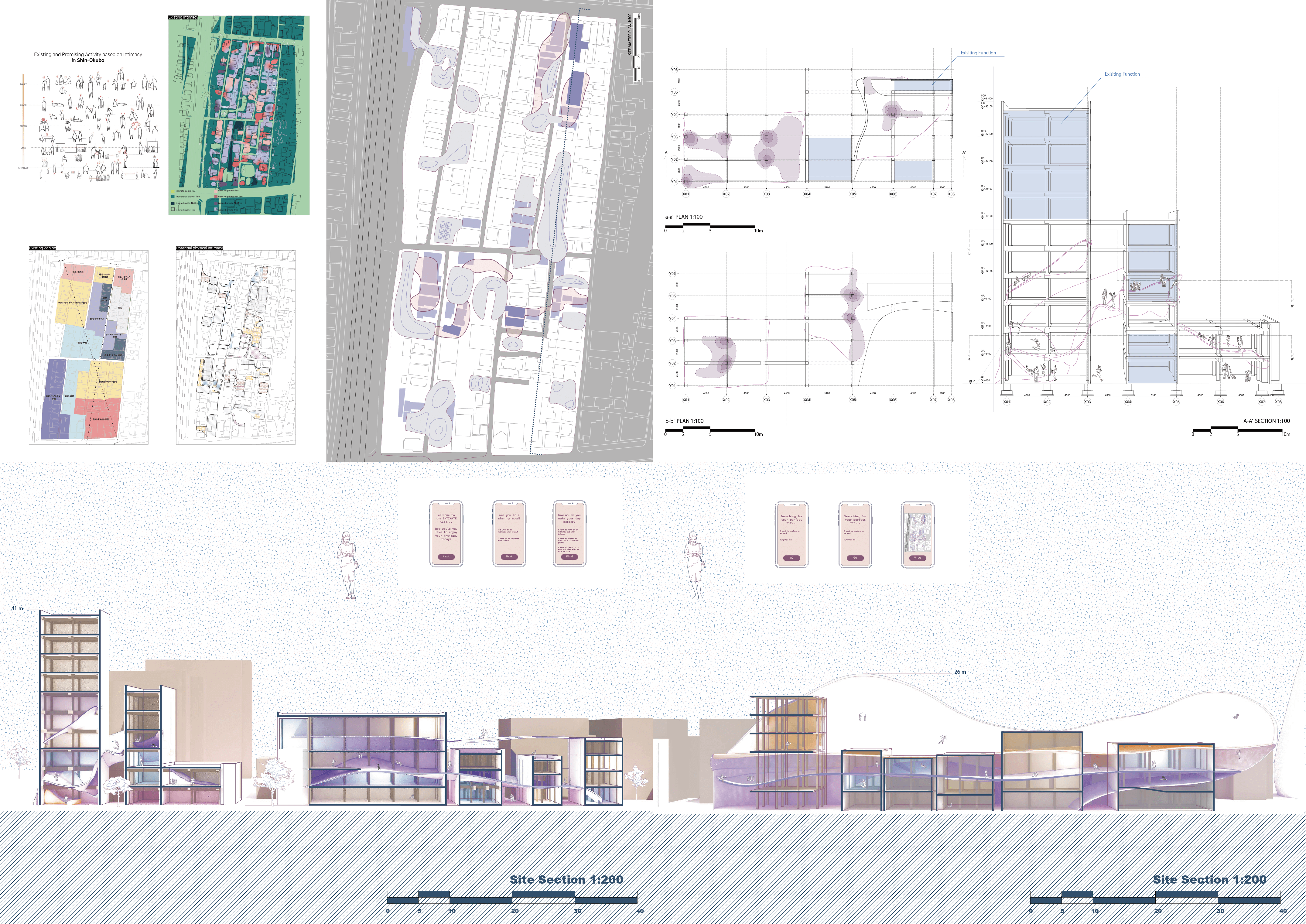
|
This project explores variations of mobility and intimacy through devising an alternate method of daily transportation.
The ever-increasing evolution of technology and the foreseeable decline in population of Japan is leading to increased idle land, changes of mobile space, and alternate working environments such as shared working space or telework is set to transform the figure of cities.
Through a new design process, “intimacy” replaces “capitalism” as the new design driver of civilization.
In this project, new urban design methodologies are proposed to promote urban culture and utilize abandoned idle land, while transportation, which enables movement between functions, is now transformed into a path of play and various new spaces cultural spaces.
このプロジェクトでは、技術の発達と人口の減少を考慮した、これまでの交通の代わりとなる新たな移動を模索する。 異なる機能間の移動が可能な交通手段は、いまや在宅勤務の増加と移動空間の変化、人口減少による無意味な空間の増加などによって、目的を持たない遊び的運動に変化している。 「親密さ」という概念を資本主義に置き換えるデザインプロセスを通して、移動空間が文化空間として生まれ変わり、新しい都市文化を伝え、捨てられた空地を活用するための新しい都市設計方法論を提示する。 |
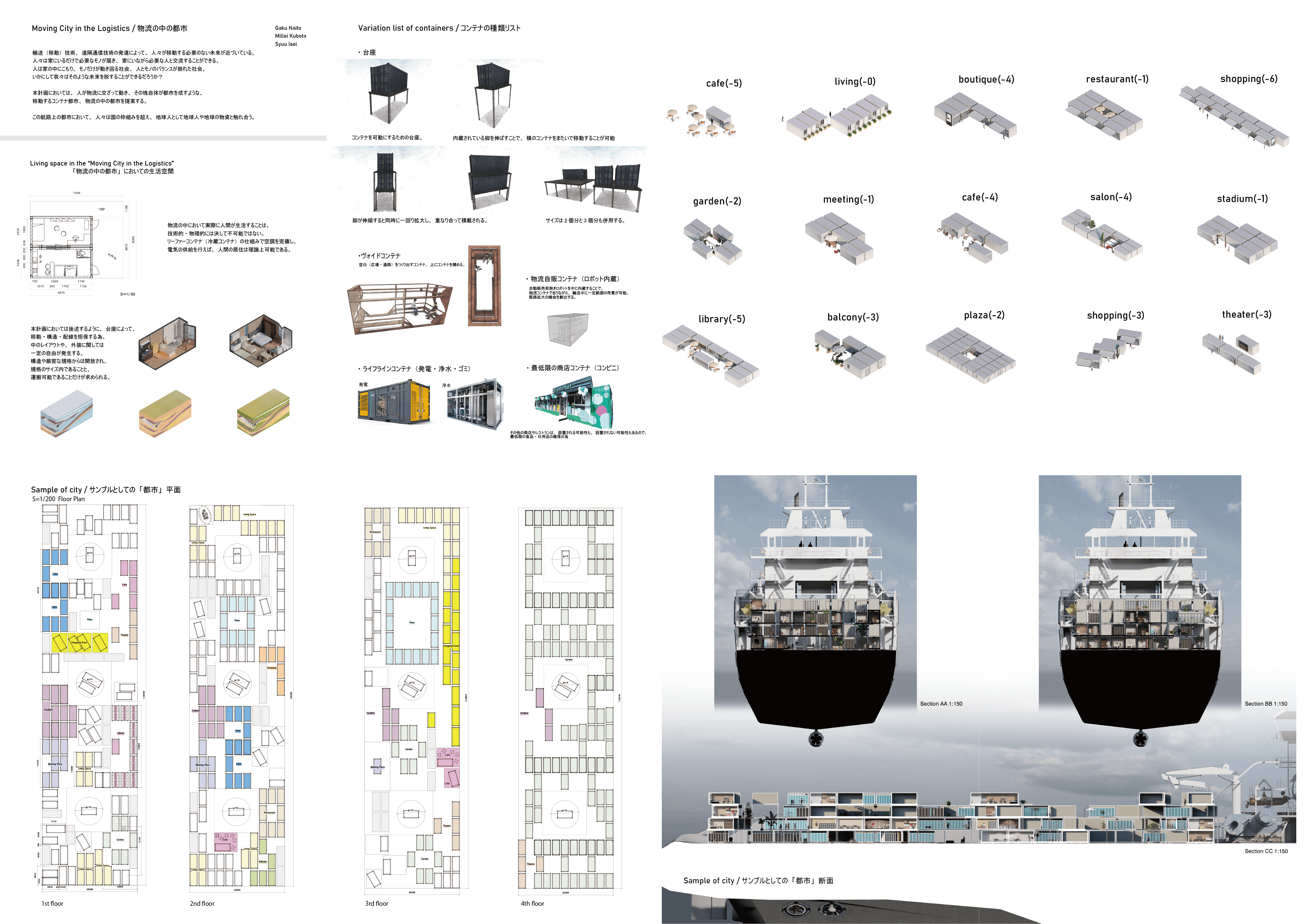
|
Advances in transportation and telecommunications technologies are approaching a future in which people do not need to move.
People can get what they need just by being at home and interact with the people they need while they are at home.
A society in which people stay in their homes and only things move around, a society in which people and things are out of balance.
How can we escape such a future? In this plan, we propose a moving container city and a city in logistics where people move among logistics and the mass itself forms a city.
In cities on this route, people go beyond national boundaries and come into contact with the earth's people and supplies as earthmen.
輸送 (移動) 技術、 遠隔通信技術の発達によって、 人々が移動する必要のない未来が近づいている。 人々は家にいるだけで必要なモノが届き、 家にいながら必要な人と交流することができる。 人は家の中にこもり、 モノだけが動き回る社会、 人とモノのバランスが崩れた社会。いかにして我々はそのような未来を脱することができるだろうか? 本計画においては、 人が物流に交ざって動き、 その塊自体が都市を成すような、移動するコンテナ都市、 物流の中の都市を提案する。 この航路上の都市において、 人々は国の枠組みを超え、 地球人として地球人や地球の物資と触れ合う。 |
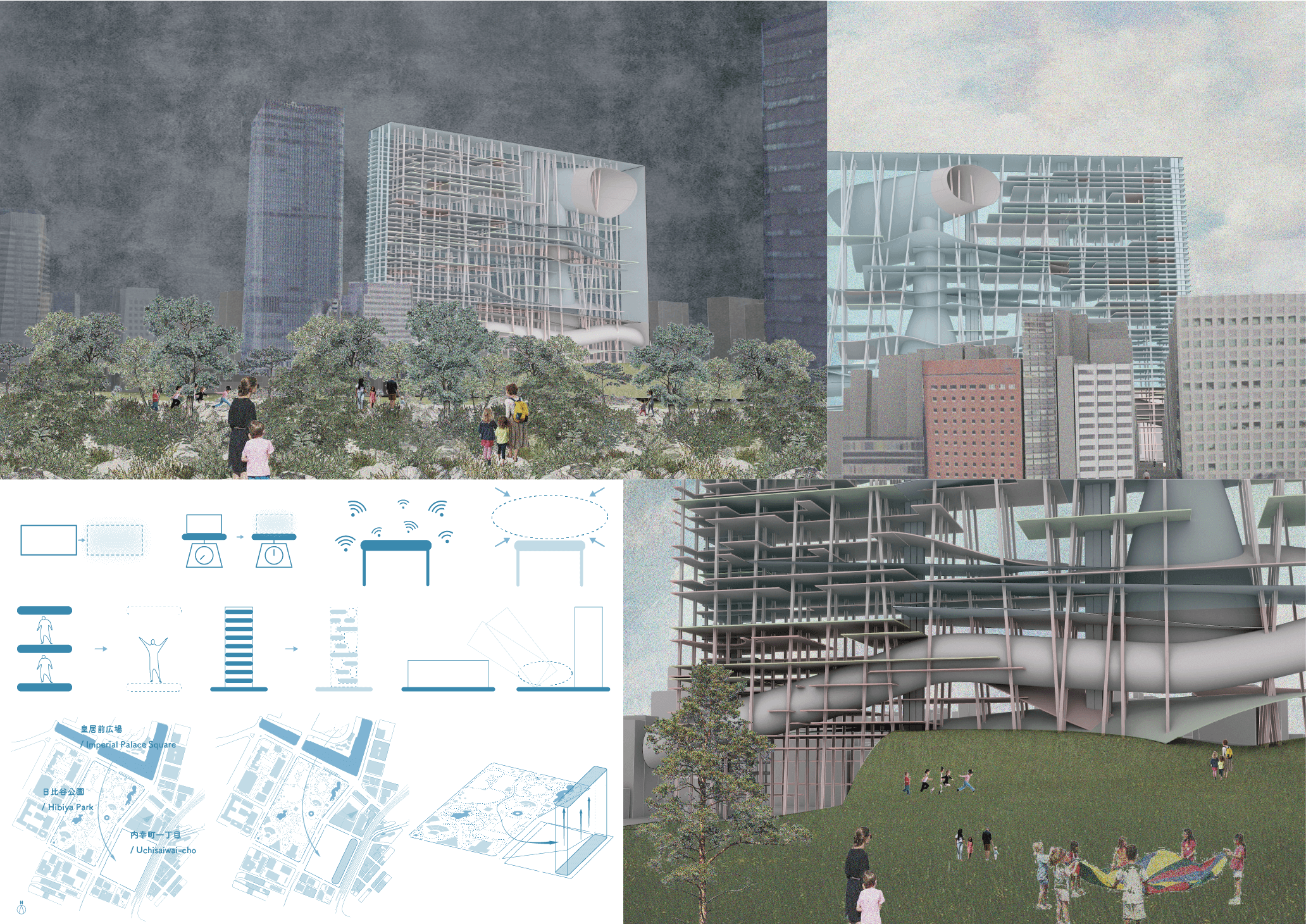
|
Gravity works on things. In order to defy the force of gravity, we have created planes and stacked them to create buildings.
It is the planes that produce economic effects, and in search of economic effects, cities have been formed as layers of planes.
However, as things become more informational, they lose their mass. In this age when there is no need to support things, this project proposes to focus on space.
We will expand personal space, remove floors, and create empty space by raising buildings that are lying all over the site.
In addition, conventional planes have been guiding human movement with economic effects.
By capturing human life in space, the expression as a style that appeared on the flat surface appears as an elevation and expresses itself in the city.
ものには重力が働きます。重力に逆らうために床という平面を作り出し、それを重ね、建物を作り出してきました。 経済効果を生み出すのが平面であり、経済効果を求めて、都市は平面の積層として形成されてきました。 しかし、ものが情報化し質量がなくなります。ものを支える必要がない時代において、本計画では、空間に着目した提案を行います。 個人の空間を拡張し、床を抜き、敷地いっぱいに寝ている建物を起こし空地を生み出し、空間にゆとりをもたらします。 また従来の平面は人間の動きを経済効果のもとに誘導してきました。 人間の生活を空間で捉えることにより、平面に現れていた様式としての表現は、立面として現れることで都市に自らを表明します。 |
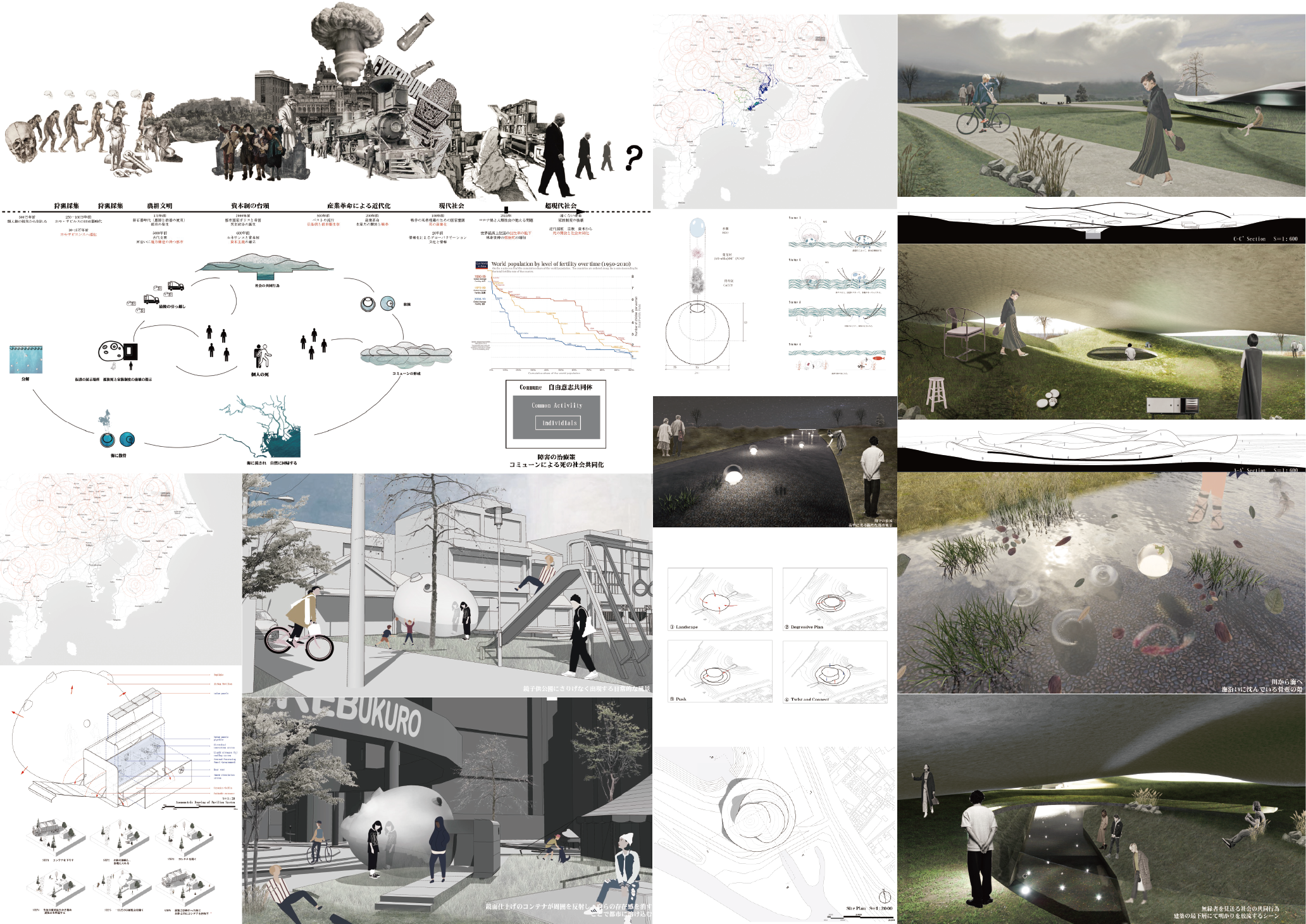
|
In recent years, something has happened that has significantly changed the civilization structure of death today. The population is aging, the birth rate is declining in major countries around the world, and the isolation death.
In the ultra-modern society, we will see the needs to propose a death infrastructure for individuals. By making the death of an individual a joint act of society, a new commune that surpasses capital and the modern nation is formed.
Excluded by modern civilization, trapped in the boundaries of the city and suspecting the existence of a graveyard, a new form of death is needed in metropolitan.
Through the existence of infrastructure, we design a series of infrastructure construction such as a funerary urn, a private exhibition hall for movement, a memorial site for drifting, and a series of infrastructure constructions in order to restore ourselves to nature.
近年に今の死の文明構造を大きく変えたことが起きていた。いわば高齢化、世界主要国の出生率の低下、独身世帯の孤独死など。超現代社会において、個人のための死のインフラの提案が必要だと捉えるだろう。 個人の死を社会の共同行為にすることで、資本と近代国家を超克する新たなコミューンを形成する。 近代文明に排除され、都市の結界に閉じ込められ墓地の存在を疑っており、大都市における死のかたちを新に提示したいと考えている。 大都市におけるインフラの存在を介して、物質に還元された我が身を自然に戻すため、骨壷、移動の個人展覧館、漂流の記念地と一連のインフラ建築を計画する。 |
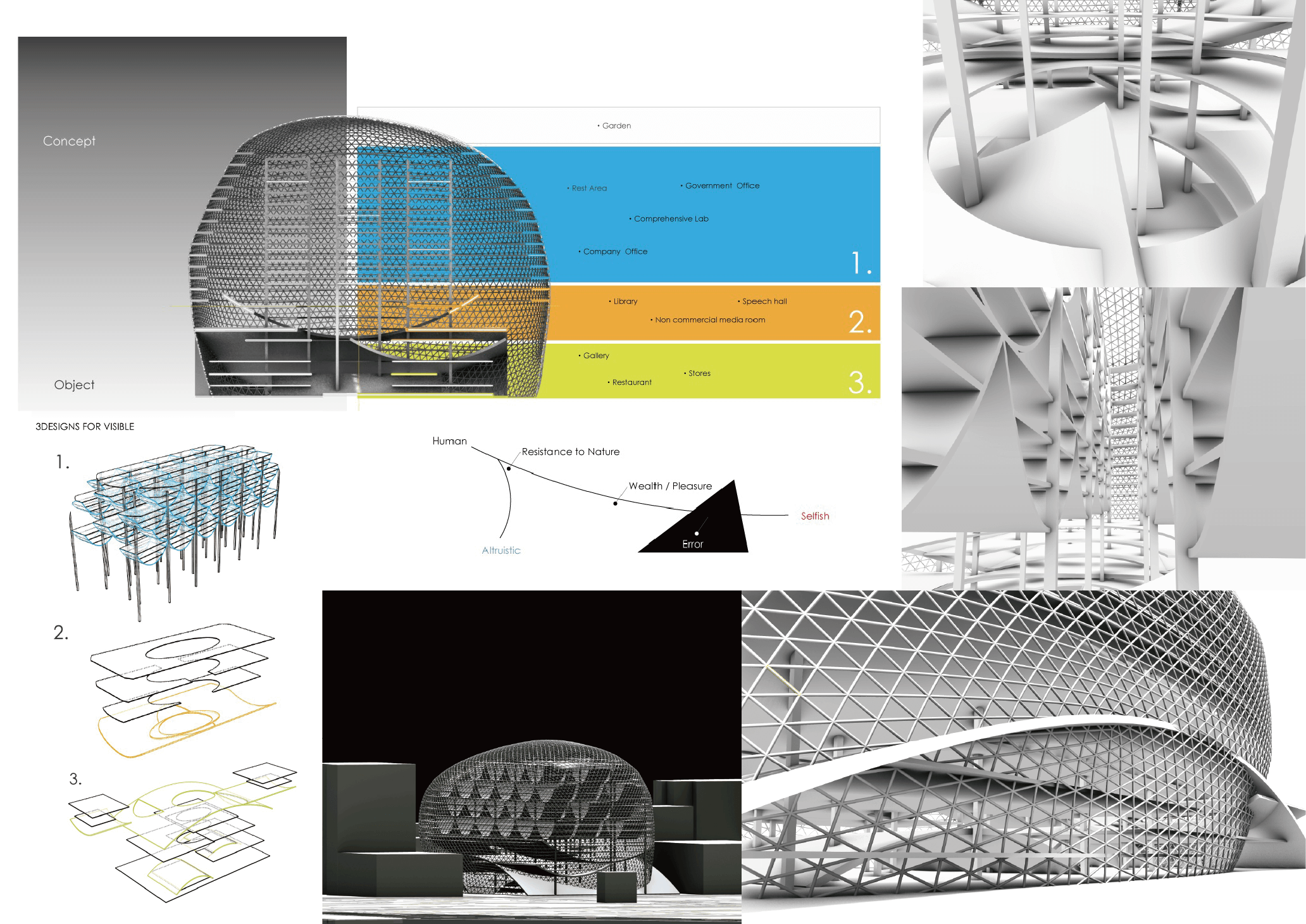
|
I believe that the problem of modern civilization lies in the inevitable "selfishness" that gave birth to civilization, and by turning to the concept of "altruism", the opposite of selfishness, I aim to solve the problems of civilization.
The architecture, which is divided into upper, middle, and lower levels, is wrapped in an "altruistic" membrane called bioskin
, which lowers the temperature of the city by allowing water to pass through, and each level deals with organizations, information, and objects.
In these areas, users can perceive and approach things outside their own domain and knowledge.
In other words, such actions are a transition to an "altruistic" state, which is the opposite of the "selfish" state of confinement to one's own domain.
Our goal is to create an architecture that will lead us to such a state and induce subsequent actions.
現代の文明の問題点は、文明が生まれる上で避けることのできなかった“利己性”にあると考え、その対極である“利他性”という概念に目を向けることで、文明における問題点を解決することを目指した。 バイオスキンという内部に水を通すことで都市の気温を下げる“利他的”膜に包まれた、上、中、下層に分かれた建築にはそれぞれ組織、情報、モノを取り扱っており、利用者はその領域の中で、自己の領域や知識外のものを知覚するとともに、それに近づくことができる。 そして、そうした行為はすなわち自己の領域に閉じこもる“利己的”状態とは逆の“利他的”状態への移行であると言える。そうした状態に導き、その後の行動を誘発するような建築を目指す。 |
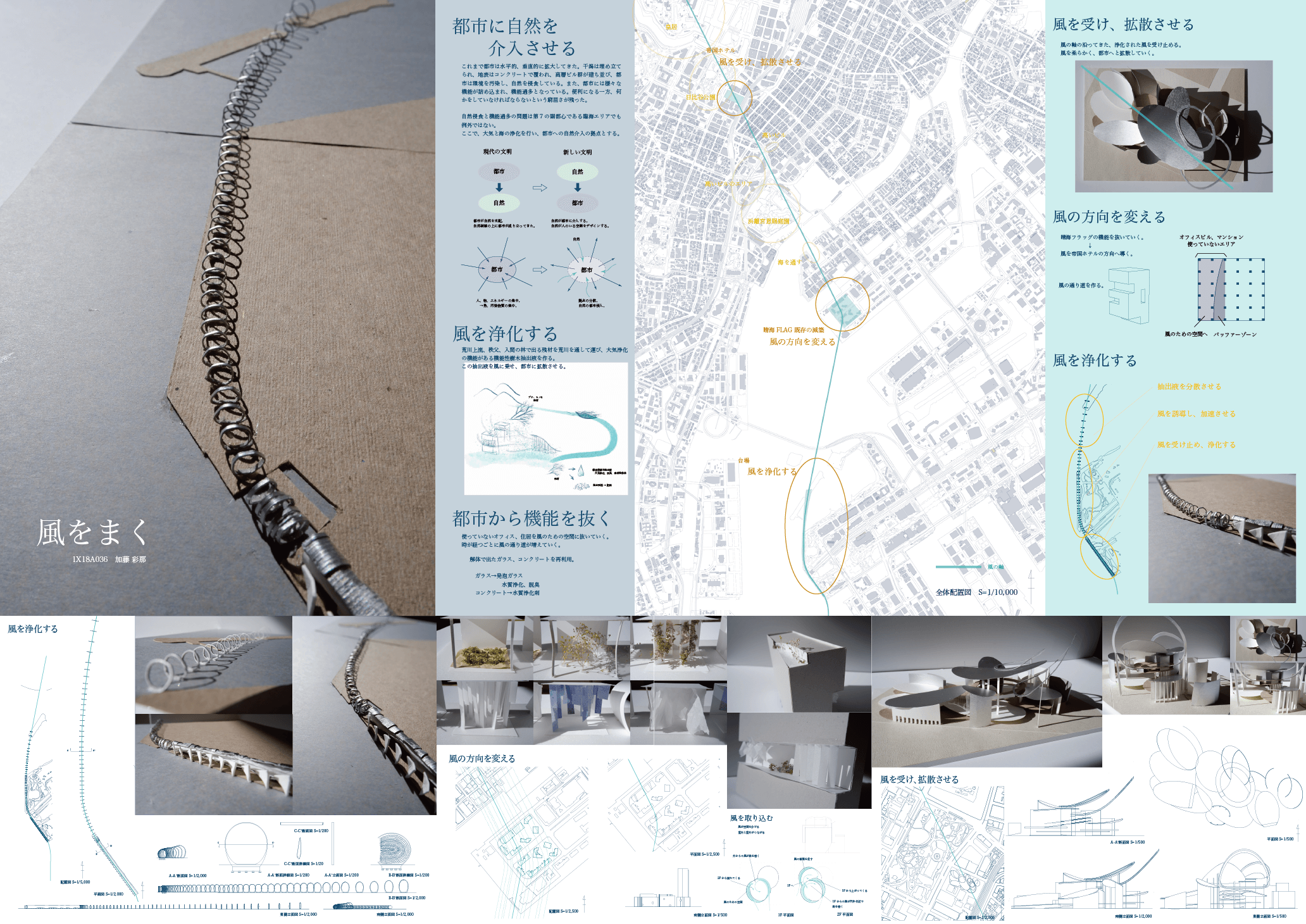
|
I redesign civilization by purifying and diffusing the wind.
In modern civilization, cities dominate nature, and cities have been built on the destruction of nature.
I reverse this relationship, let nature intervene in the city, and design the space by nature.
I will solve the problems of modern cities such as environmental destruction, over-concentration, and over-function by purifying and spraying wind.
Three bases will be set up at Daiba Shiokaze Park, Harumi FLAG, and the site of the Imperial Hotel, and will have the functions of purifying the wind, changing the direction of the wind, receiving and diffusing the wind in order from the south.
The wind not only suppresses the heat island phenomenon, but also enriches people's lives.
風を浄化し、拡散することで文明の再設計を行う。現代の文明では、都市が自然を支配し、自然破壊の上で都市が成り立ってきた。 この関係性を逆転させ、都市に自然を介入させ、自然による空間のデザインを行う。環境破壊、一極集中、機能過多といった現代都市の問題を、風の浄化と散布によって解決していく。 台場潮風公園、晴海FLAG、帝国ホテル跡地に3つの拠点を設け、南から順に、風を浄化する、風の向きを変える、風を受け、拡散させるという機能を持たせる。 風は、単にヒートアイランド現象を抑制するだけでなく、人々の生活を豊かにするのである。 |
Copyright (C) 2014 Watanabe Taishi Laboratory, Department of Architecture, Waseda University. All Rights Reserved.